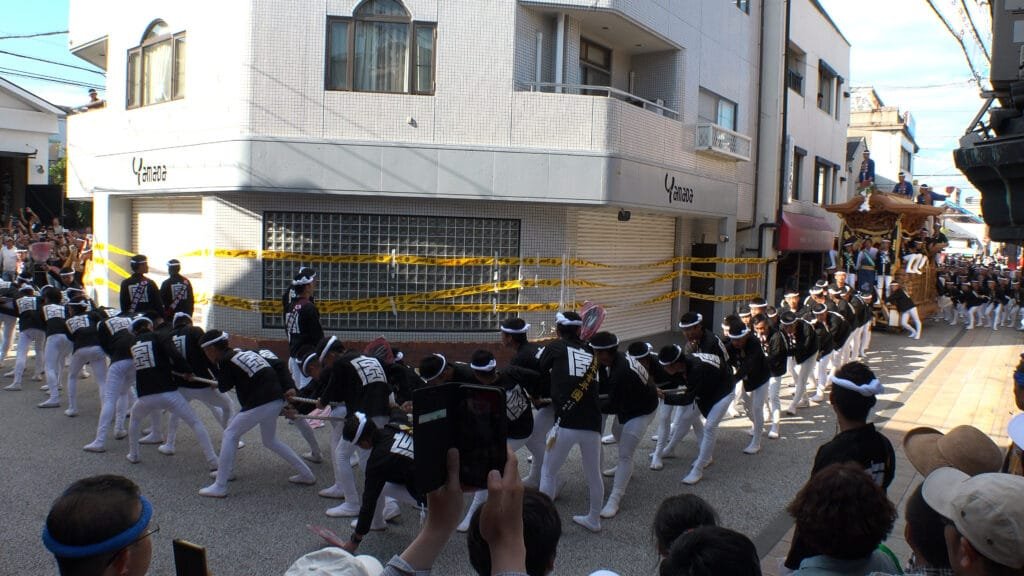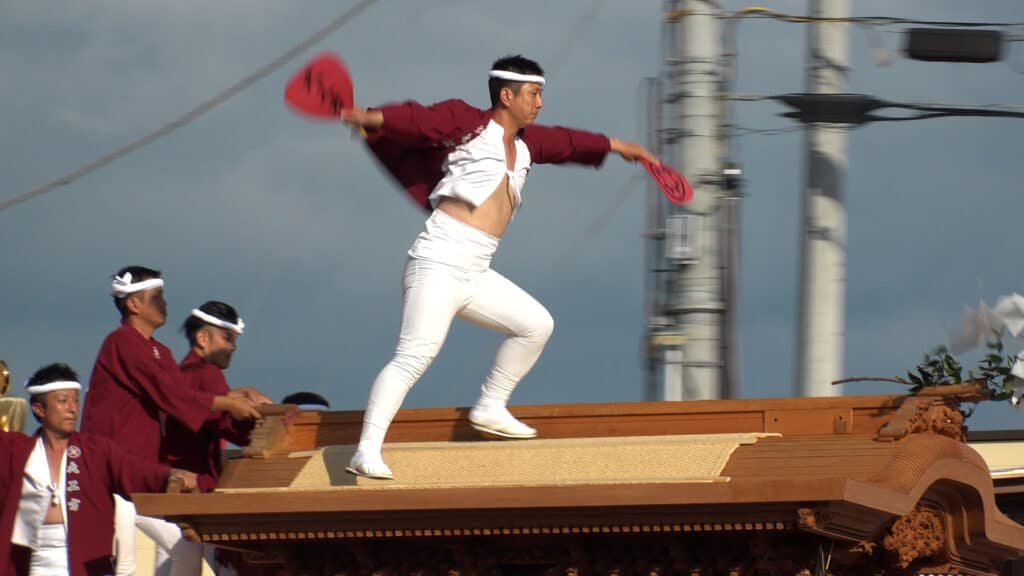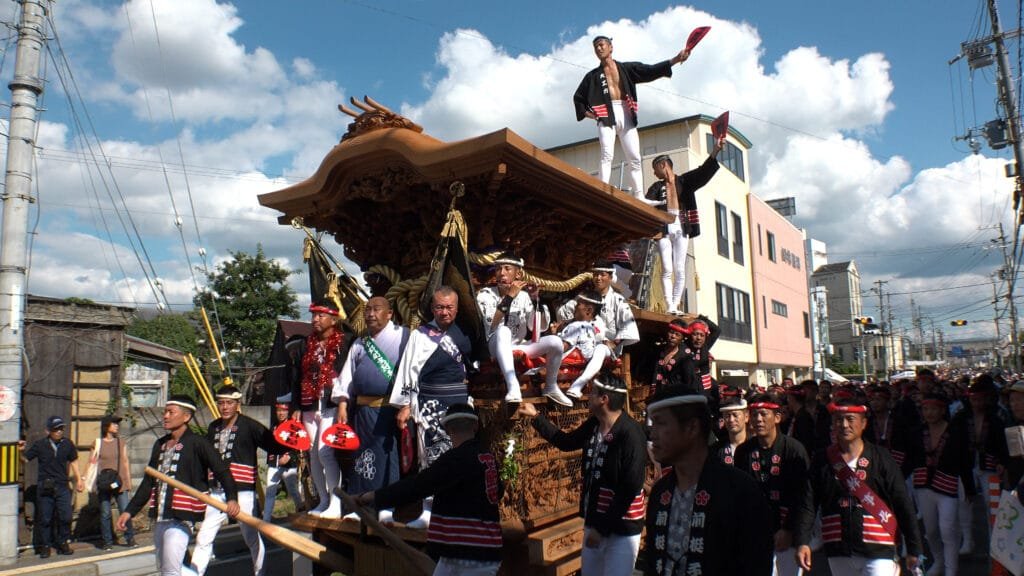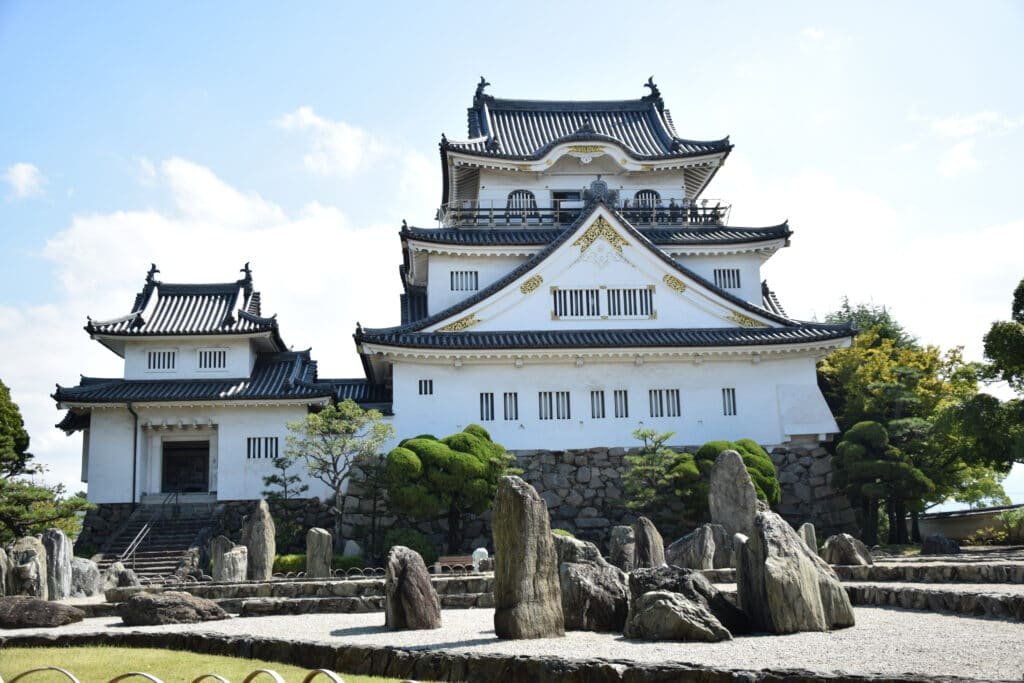
Table of Contents
What is the Kishiwada Danjiri Festival?
Kishiwada Danjiri Festival separates into two, one held in September and the other in October. The festival in September takes place in Kishiwada district and Haruki district. Meanwhile, the one in October takes place in East Kishiwada district, Minami-Kishiwada, Yagi, Yamanao, Yamadaiminami, and Yamataki districts. The September festival is the more famous of the two and takes place on the 14th and 15th, every year. Additionally, it takes place at Kishiwada Castle.
The festival includes a somewhat aggressive parade. Over 400 men pull a Danjiri throughout the streets of Osaka, mimicking a roaring dragon. The Danjiri nimbly maneuvers around the narrow streets of Osaka. This all whilst a man dances and shouts on top! The highlight of the festival is the “Yarimawashi” – the act of turning the Danjiri around 90-degree corners without slowing down. You can marvel spirit of unity, teamwork, and energy that everyone must have practiced so tirelessly for. The combination of the taiko drum beats and the relentless shouting is something so unique to this festival. It really does feel like a roaring dragon rushing through the streets of the city!

The evening parade is quite the contrast to the daytime events. Around 200 lit paper lanterns cover the Danjiri giving a mystic and elegant atmosphere. The “Yakan-eiko” features a mix of adults and children slowly pulling the Danjiri. In contrast to the daytime events, you can see the Danjiri up close to really appreciate the skill and technique used to make them.

What is a Danjiri?
Danjiri is an ornately crafted wooden structure with detailed carvings of ancient battles and myths in Japan’s history. These floats can weigh up to 4 tons so it takes masses amount of manpower and energy to carry it around. Furthermore, around 35 Danjiri floats are created and paraded around Kishiwada city.
Breakdown of a Danjiri
A Danjiri takes a lot of co-ordination and manpower to move, so let’s go through the setup.
At the top is the matoi, which is a type of flag. These represent different towns so you can distinguish where each Danjiri is from.
Next is the Tsunasaki, or Tsunanaka, which is the main pulling power of the Danjiri. It is the end of the rope so the people pulling have to be physically strong and fit.
The role closest to the Danjiri is called Tunamoto, the puller. It plays an important role in slowly transmitting the power of the rope when turning around.
Next is one of the most dangerous roles. A cypress lever is inserted in between the rotating surface of the front lever top and the ground wheel to control the Danjiri. When turning around, the inner front lever creates a trigger for turning, which suppresses the rotation of the inner top. This makes it easier to turn the top of the Danjiri. As a result, this is extremely dangerous and skilled people can only control this part.
The rear lever helps steer the Danjiri. They change direction by pulling the rope tied to the left and right or pushing it with thier shoulder.Finally, On top of the Danjiri is the “carpenter”. He can see all around and helps to instruct the rear lever in the right direction. This is all while dancing with a tradition Japanese fan above their head.

History of Kishiwada Danjiri Festival
The festival dates back to over 300 years ago, in 1703. The lord of Kishiwada City, Okabe Nagayasu, went Kyoto Fushimi Inari to pray for a bountiful harvest. The prayers were for a healthy harvest of grains, such as rice, wheat, and beans. This became an annual tradition and then into the festival we know today. Many festivals change throughout the years as they become tamer to adjust to modern society. However, Kishiwada Danjiri festival has always had a wild side to it, which has been carried throughout the years. Even today, deaths are uncommon as people are crushed under the Danjiri or the person on is thrown off!
Kishiwada Castle
Kishiwada Castle ties deep with the festival’s origins. The original structure was struck down by lightning in 1827 and was rebuilt in the city center. Here, many people could access it and it became an important landmark in the city of Osaka. Historic artifacts and archives are available to view but are mostly in Japanese. On the top floor is an impressive 360-degree view of Kishiwada City and Osaka Bay.
Furthermore, amongst the castle grounds is an elaborate stone garden. The “Garden of Eight Battle Formations”, completed in 1953 by Mirei Shigemori, replicates the strategic positioning of famous Chinese mythical battle. From the thrid story of the castle, you can view the stone garden from above.
Close by is the world famous museum Danjiri Kaikan. You can buy a joint ticket to both landmarks for a reduced price of 700 yen. It makes for a great day out while learning about the history of the city.

Watch a video on the Kishiwada Danjiri Festival here:
Where to enjoy Kishiwada Danjiri Festival
The festival takes place at Kishiwada city so accessing my train is the best option. The September festival is located in all areas of Kishiwada and Haruki districts. The October festivals take place in districts of Yagi, Minamikamori, Higashi-kishiwada, Yamadai, Yamadai-minami, and Yamataki. If you are coming from downtown Osaka, use the Nankai Railway.
Address : 1-10 Miyamotocho, Kishiwada, Osaka 596-0054
Website : www.city.kishiwada.osaka.jp/site/danjiri/
Festival dates :
September festivals
September 14th and 15th (Held annually on the weekend prior to Respect-for-Senior-Citizens Day)
14th – 6:00~22:00
15th – 9:00~22:00
October festivals
October 12th and 13th (Held annually on the weekend prior to Physical Fitness Day)
12th – 6:00~22:00
13th – 9:00~22:00
Festival times may vary between the districts
Final
The Kishiwada Danjiri Festival is one of the most exciting and heart pumping events in all of Japan. The city of Kishiwada comes alive with the roar and beat of the drums. Check out the night festival as well to experience a calmer, more elegant side to the action packed Danjiri festival!






















this article is very useful, thank you for making a good article